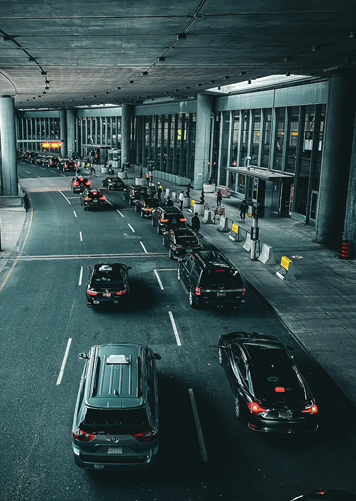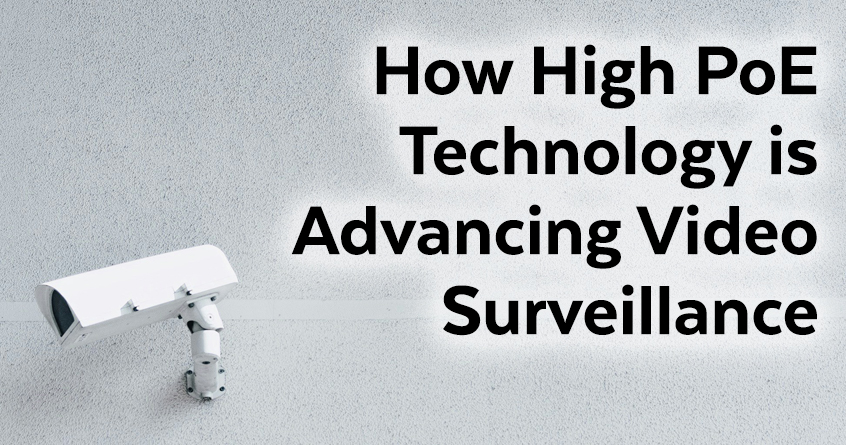Surveillance technology has come a long way from the VHS-based systems of the 1970s. With a maximum storage capacity of two hours of continuous recording or the equivalent of about eight gigabytes of data, these older systems required special handling to ensure adequate coverage. Modern security systems have expanded far beyond these limitations. By leveraging cloud technology, these systems offer increased storage capacity, improved security, and enhanced data privacy. Incorporating artificial intelligence allows real-time analysis of surveillance video feeds for better crowd control, data-driven predictions, and automated dispatching of first responders. These advanced capabilities require more power and faster transmission speeds, and a new technology known as high PoE has risen to meet that need, quickly becoming an integral component of modern surveillance systems.
What is High PoE?
High Power over Ethernet (PoE) refers to the 802.3bt standard issued by the Institute of Electrical and Electronics Engineers (IEEE). 802.3bt allows up to 90 watts of power to be sent over an Ethernet cable for power-hungry devices like lighting systems, wireless access points, and surveillance cameras.
High PoE can also support the higher transmission speeds often required to use these power-intensive devices. Sending power and data over a single Ethernet cable simplifies installation and enables device placement in remote locations where external power sources may be difficult or impossible to come by. High PoE supports data-heavy AI applications while providing deployment flexibility to the cloud, on-premise, or both.
What Are Today’s Surveillance Trends?
With some incredible advances in surveillance technology, organizations are struggling to integrate these new capabilities with legacy systems in an efficient and cost-effective way. Property owners seek ways to expand beyond traditional crime prevention and detection methods to maximize their return on investment (ROI). Cities use advanced camera features to improve resident safety by minimizing traffic and crowd congestion. Innovative applications of surveillance technology are changing today’s security landscape.
Bubble, Bubble, Toil and Trouble
In Opelika, Alabama, pranks and vandalism against a cherished fountain cost the city thousands of dollars in repair and maintenance expenses. During celebratory town events, The fountain, located in the city square, was often filled with bubbles after celebratory events. Pranksters would add soap to the water basin and watch as the fountain’s pump systems produced mountains of bubbles.
Unfortunately, such incidents cost the city of 40,000 residents up to $30,000 in clean-up and repairs, often requiring total replacement of the pumps. When these incidents peaked at 17 in a single year, the city sought an innovative solution to prevent the damage from occurring again.
Although the city had video surveillance around the fountain, it was insufficient to deter pranksters, so they developed an AI-based solution to detect bubbles in the water. The city deployed high-resolution cameras combined with AI applications to detect bubbles in real-time and, when activated, send shutdown commands to the pumps, preventing the soap from entering the system before it could damage the pumps.
Combining advanced surveillance technologies saved the city thousands by deploying cameras in remote locations that sent real-time video to the cloud for AI-driven analysis. The implementation has been so successful that Opelika plans to deploy similar proactive solutions. High PoE can support high-resolution cameras in remote locations where power is unavailable. Its data transmission speeds can facilitate data transfer from the camera to the cloud.
I Spy
The children’s game, colloquially known as “I Spy,” requires players to identify something the “spy” sees using the object’s first letter. The game continues until the correct object is identified. Older video surveillance systems operated in the “I Spy” mode, requiring security personnel to monitor video feeds manually, looking for anomalies.
Today’s surveillance systems use AI algorithms to analyze incoming video to protect people and property. For example, bottlenecks are a significant concern in traffic and crowd control. Traffic congestion frustrates drivers and increases the chances of an accident. Stalled crowds can become unruly and enflame tempers, leading to unwanted altercations.
Airports
Congestion is not restricted to roadways. Airports, event venues, and hospitals all experience bottlenecks. AI technology can play “I Spy” thousands of times faster than humans, allowing it to detect predictive patterns for more rapid intervention. AI can count the cars entering and exiting an arrival area. When the count reaches a pre-set threshold, the system alerts security personnel to help move waiting cars. Placing high PoE sensors throughout the arrival area improves airport security without significantly increasing operating costs, delivering power and data over a single connection.
Event venues
Protecting people and property at outdoor venues can be challenging. Venue owners can deploy high PoE devices such as lights, sensors, and video cameras even in remote locations that lack direct access to power. Motion detectors can sense unexpected intrusions, relaying data to an AI application capable of determining whether the intruder is an animal so security personnel can confirm false alarms remotely. High PoE lights and motion detectors can increase visibility throughout a venue at a minimal cost. As visitors move into poorly lit areas, motion detectors can activate security lighting systems, providing better visibility for cameras and people.
Leveraging Advanced Technologies
Surveillance technology combines AI, cloud services, and high PoE to enhance physical security and safety. Using these technologies, cities like Opelika can prevent property damage while still pursuing vandals through video surveillance. They can deliver services cost-effectively by combining power and data delivery over Ethernet cables and structuring a hybrid infrastructure for on-premise and cloud services.
Using high PoE switches, public facilities can integrate older devices into modern infrastructures to facilitate budget-friendly incremental upgrades. AI-enabled switches can manage power routing to edge devices, eliminating the cost of stay-alive electrical requirements. They can also deliver enterprise-wide data on PoE devices to maximize uptime. Incorporating AI at all levels of a surveillance system increases security and reduces costs. Well-trained AI solutions mean security personnel waste less time pursuing false alarms.Versa Technology strongly advocates power over Ethernet (PoE) technologies. Their products incorporate the latest in surveillance technology for improved protection of people and property. Their high PoE solutions support high-performance wireless access points, digital signage, high-resolution security cameras, and access control systems. Their knowledgeable staff can assist companies wanting to deploy advanced surveillance technologies cost-effectively. Contact Versa Technology to learn more about high PoE.
 VX-GPF1626 24-Port GbE RJ45 + 2-Port GbE RJ45/SFP Web Smart+ GbE Managed PoE+ Switch
1 × $515.00
VX-GPF1626 24-Port GbE RJ45 + 2-Port GbE RJ45/SFP Web Smart+ GbE Managed PoE+ Switch
1 × $515.00  VX-GPU2610 L2+ 4-Port 802.3bt PoE + 4-Port 10/100/1000TX + 2-Port 100/1000X SFP Managed GbE UPOE Switch (240W, DMS)
1 × $489.00
VX-GPU2610 L2+ 4-Port 802.3bt PoE + 4-Port 10/100/1000TX + 2-Port 100/1000X SFP Managed GbE UPOE Switch (240W, DMS)
1 × $489.00 


